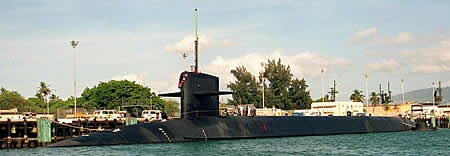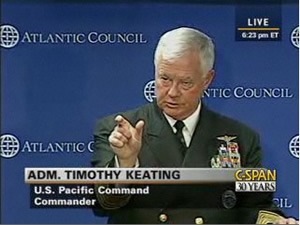 |
| PACOM Commander Admiral Keating is “unaware” of the Japanese interest in the nuclear Tomahawk cruise missile reported by the Congressional Strategic Posture Commission. |
By Hans M. Kristensen
Admiral Timothy J. Keating, who is Commander of U.S. Pacific Command, said Monday that he is “unaware of specific Japanese interests in the” nuclear-armed Tomahawk Land-Attack Missile.
That’s interesting because the Congressional Strategic Posture Commission recently pointed explicitly to such a Japanese interest in the role that the missile – known as the TLAM/N – provides in extending a U.S. nuclear umbrella over Japan to deter nuclear attacks against it from China and other potential adversaries in the region.
We would expect the commander of Pacific forces to be in close contact with the highest levels of the Japanese government and military. Shouldn’t he be aware of a specific Japanese interest in specific weapons for the U.S. nuclear umbrella? So statements to the contrary in the recent Congressional Commission report seem odd and worth investigating.
The Claims
The final report of the Congressional Commission on the Strategic Posture of the United States of America makes several claims about Japan and the TLAM/N, primarily that:
“extended deterrence [in Asia] relies heavily on the deployment of nuclear cruise missiles on some Los Angeles class attack submarines—the Tomahawk Land Attack Missile/Nuclear (TLAM/N). This capability will be retired in 2013 unless steps are taken to maintain it. U.S. allies in Asia are not integrated in the same way into nuclear planning and have not been asked to make commitments to delivery systems. In our work as a Commission it has become clear to us that some U.S. allies in Asia would be very concerned by TLAM/N retirement.”
Indeed, the report states that the TLAM/N is “primarily relevant to extended deterrence to allies in Asia.”
According to several sources, Japanese government officials provided the Commission with a written list of requirements for the nuclear umbrella. Neither the list not the wording of the Japanese statements are included in the report, which provides the following statement without mentioning Japan by name: “One particularly important ally has argued to the Commission privately that the credibility of the U.S. extended deterrent depends on its specific capabilities to hold a wide variety of targets at risk, and to deploy forces in a way that is either visible or stealthy, as circumstances may demand.”
The U.S. Nuclear Posture in the Pacific
The United States has approximately 300 nuclear-armed TLAM/N, of which about half are stored in igloos at Strategic Weapons Facility Pacific (SWFPAC) near Bangor, Washington (the other half or so are at Strategic Weapons Facility Atlantic (SWFLANT) at Kings Bay, Georgia).
Only about 100 of the TLAM/N warheads are active with limited-life components installed, but none of the missiles are deployed on attack submarines under normal circumstances. Less than a dozen of the 53 U.S. attack submarines are capable of firing the TLAM/N, and although the boats and crews periodically undergo training and inspections to certify them for the mission, they are de-certified again to focus on real-world non-nuclear missions. It would take several months to ready the missiles, recertify the submarines, and deploy the missiles at sea.
The approximately 150 TLAM/N at SWFPAC represent but a fraction of the U.S. nuclear posture in the Pacific, which includes well over 1,000 W76 and W88 warheads for Trident II sea-launched ballistic missiles (SLBMs) on eight Ohio-class nuclear-powered ballistic missile submarines (SSBNs) patrolling the Pacific Ocean. Five-six of the eight Pacific SSBNs with an estimated 480-570 warheads onboard are deployed at any given time. Hundreds of additional warheads stored at SWFPAC are available for increasing loading on the SSBNs to an estimated 1,300 warheads if necessary.
| USS Henry M. Jackson (SSBN-730) in Hawaii |
 |
| The nuclear umbrella over Japan is supported by a huge nuclear arsenal in the Pacific region, including SSBNs such as this one that continuously patrol the Pacific and occasionally make their presence known by visiting Hawaii and other Pacific ports. |
In addition to this sea-based force, a portion of the 500 warheads on 450 Minuteman III Intercontinental Ballistic Missiles (ICBMs) also cover strike options in the PACOM region, as do B-2 and B-52H bombers with nuclear bombs and cruise missiles. Moreover, F-15Es of the 4th Fighter Wing at Seymour-Johnson Air Force Base in North Carolina have contingency a nuclear strike mission in the Pacific (and elsewhere).
In addition to these nuclear forces, the U.S. Navy is moving 60 percent of its carrier battle groups and nuclear attack submarines into the Pacific. One of these battle groups is even homeported in Japan. Naval exercises in the Pacific are now bigger than even during the Cold War. The Air Force is rotating long-range bomber squadrons to Guam more or less continuously.
Why, given these extensive U.S. forces earmarked for the Pacific region, anyone in Tokyo, Washington, Beijing or Pyongyang would doubt the U.S. capability to project a nuclear umbrella over Japan – or see the TLAM/N as essential – is puzzling. While not all of these warheads are necessarily intended for the defense of Japan per ce, just how many are is probably irrelevant for the purpose of deterrence and assurance. Even if the posture were cut by fifty percent, more than three times the entire Chinese nuclear stockpile would still remain, enough to deter any real-world adversary – to the extent anything can.
The Nuclear Lobby: Articulating a Persuasive Nuclear Mission
So why do we suddenly hear all this talk of Japan being deeply worried about the future of a few hundred TLAM/Ns? After all, nearly all U.S. presidents since Kennedy have called for the elimination of nuclear weapons. As a nuclear target in World War II Japan has always called for the elimination of nuclear weapons, perhaps a little disingenuous given its reliance on the U.S. nuclear umbrella and Japanese officials privately saying that elimination probably wouldn’t happen anyway. Yet the growing international momentum across the traditional political trench-lines for moving convincingly down the nuclear ladder toward zero appears to have caught some in the Japanese government by surprise. Now they suddenly have to think about what it means to move toward zero, and change is always hard.
Another reason appears to be that the end of the Cold War and a growing momentum toward a nuclear free world – even supported by even the presidents of the United States and Russia – have left defense hawks and nuclear proponents on the defensive. Chinese modernization, rogue states, and terrorism haven’t quite been able to sustain the nuclear vigor after the demise of the Soviet threat. In that void, obscure and confidential statements from Japanese and other allied officials about extended deterrence have suddenly become essential tools in an attempt to articulate a persuasive – even positive – enduring role for nuclear weapons. The essence of the message is: nuclear weapons prevent proliferation of nuclear weapons and without them more will come.
It’s tempting to see a collusion. In December 2006, the Defense Science Board (DSB) task force on nuclear capabilities warned that “entrenched views” of arms control advocates had robbed the United States of its “national consensus” on the role of nuclear weapons. The White House and senior leaders had to “engage more directly to articulate the persuasive case” for how modern nuclear weapons serve U.S. national security policy.
After clumsy attempts to get Congressional approval for Complex 2030 and the Reliable Replacement Program backfired and instead caused Congress to ask for a review of nuclear policy, a four-page joint DOD-DOE-State Department statement in July 2007 attempted to articulate one but fell short. And although the loss of control of six nuclear warheads at Minot Air Force Base the following month initially put the nuclear enterprise in doubt, the incident has since become an important vehicle for arguing the case urged by the DSB. During the past 12 months, a series of reports by government agencies and defense institutes have emerged that echo the same basic themes of an enduring role for nuclear weapons, need for modernizations, and continued nuclear threats. The extended deterrence mission underpins these themes:
* September 2008: Schlesinger Task Force Phase I report on the Air Force’s nuclear mission
* September 2008: joint DOD-DOE report on nuclear weapons in the 21st century
* October 2008: Air Force Task Force report on reinvigorating the Air Force nuclear enterprise
* January 2009: Schlesinger Task Force Phase II report on the DOD nuclear mission
* May 2009: Congressional Commission report on the strategic posture of the United States.
These reports, authored by agencies and individuals that are or have been deeply involved in the nuclear business (and many of which “ran the Cold War”), argue for a reaffirmation – even strengthening – of extended deterrence as a “good” and enduring mission for nuclear weapons to prevent proliferation in the 21st Century. They argue that since the U.S. nuclear umbrella is extended to some 30 countries (one report even says 30-plus countries; I can only count 30) it prevents them from acquiring nuclear weapons themselves. Yet for the overwhelming majority of those countries, the function of the extended deterrent is not about nonproliferation but about the ultimate security guarantee. The number of those countries that could potentially be expected to develop nuclear weapons if the U.S. nuclear umbrella disappeared is very small, perhaps a couple, and whether they would actually do so depends on a wide spectrum of factors, most of which have nothing to do with nuclear weapons. Yet the reports paint the role of nuclear weapons as alpha omega.
| James Schlesinger |
 |
| James Schlesinger, who like many other key contributors to recent nuclear studies helped shape Cold War nuclear planning, has been granted a powerful role in articulating post-Cold War policy. |
The September 2008 Schlesinger report describes a “daily” contribution of nuclear weapons, a theme that is echoed by many of the other reports and has been used in testimony before Congress: “Though our consistent goal has been to avoid actual weapons use, the nuclear deterrent is ‘used’ every day by assuring friends and allies, dissuading opponents from seeking peer capabilities to the United States, deterring attacks on the United States and its allies from potential adversaries, and providing the potential to defeat adversaries if deterrence fails.”
One has to be very careful about such nuclear dogma because it quickly can balloon the perceived contribution, mission, and requirements beyond reality. Since the end of the Cold War, which country can we actually say has been deterred by nuclear weapons from attacking anyone, which country has been dissuaded by nuclear weapons from pursuing advanced military capabilities, and which allied or friendly country has been assured by nuclear weapons from pursuing nuclear weapons? This list is very small and the evidence dubious and circumstantial even in the best cases.
Yet the combined effect of these studies and the lobbying that accompany them appears to be setting the tone, at least at the outset, for the Obama administration’s Nuclear Posture Review. Extended deterrence has risen to the top of the agenda and has been assigned to one of only four working groups in the review (International Dimensions), instead of incorporating analysis of that mission into the Policy and Strategy working group like the other missions.
Concluding Remarks
It is impossible to say to what extent Admiral Keating was aware of the public relations battle that is raging on the nuclear extended deterrence front when he gave his answer at the Atlantic Council. I think he was. He certainly looked like he was choosing his words very carefully.
Nuclear advocates and defense hawks appear to be milking the extended deterrence mission for all it’s worth to secure funding for pet projects such as the TLAM/N, a replacement missile, and a nuclear role for the F-35 Joint Strike Fighter, capabilities that are not needed. Yet the Congressional Commission report concludes that assuring allies that the U.S. extended deterrent remains credible and effective “may require that the United States retain numbers or types of nuclear capabilities that it might not deem necessary if it were concerned only with its own defense.” Indeed, the Commission said, echoing the January 2009 Schlesinger report, the extended deterrence mission has “design implications for the posture” and nuclear weapons “modernization is essential to the non-proliferation benefits derived from the extended deterrent”.
| Admiral Timothy J. Keating |
 |
| The head of PACOM, Admiral Timothy Keating, says he is “unaware of specific Japanese interest in that particular system” (TLAM/N) described recently by the Congressional Strategic Posture Commission. |
The issue is not whether there should be an extended deterrent or not but what characteristics it needs to have and for what purpose. Nuclear cruise missiles and dual-capable fighter aircraft are characteristics of what nuclear extended deterrence looked like the Cold War, but they might not be necessary or even appropriate today. Long-range systems might be sufficient. Whatever Japanese officials have said about the composition and role of the U.S. nuclear umbrella, there is probably more to the story than meets the eye. Even if some Japanese express a unique value in the TLAM/N – the U.S. military certainly does not share that view – what they say might tell us more about what deterrence literature and Cold War history they have read and which U.S. officials they meet with.
To that end I find it curious that the Japanese government apparently has not brought its alleged interest in the TLAM/N to the attention of PACOM even though that command works with Japanese officials on a daily basis to provide the military capabilities that make up the U.S. security guarantee to Japan. And it is not because PACOM is not aware of their interest in the nuclear umbrella. In the words of Admiral Keating, responding to a question from Miles Pompers from the Center for Nonproliferation Studies:
“As I move around the [PACOM Area of Responsibility]…sooner or later many of the folks with whom we have discussions will get around to asking ‘is your nuclear deterrent umbrella going to continue to extend over’ fill-in-the-blank country? So our capabilities in this area are not taken for granted all throughout our area of responsibility. Everywhere I go, sooner or later – not just in mil-to-mil – the conversation comes up.
I am unaware of specific Japanese interest in that particular system [TLAM/N] you describe. I am, as I said, aware of Japanese interest in the nuclear umbrella.”
It is important for the quality and credibility of the nuclear extended deterrent debate here in the United States and elsewhere to see what the Japanese officials have said and provided, what status and function the officials have within the Japanese government (the Commission report only identifies four individuals from the Japanese embassy in Washington, D.C.), and exactly what they were asked and by whom. The reason is, as all officials know, that questions asked and answers given are always influenced by such factors. It would serve neither the United States nor its allies if the future U.S. nuclear extended deterrence policy and capabilities were to fall victim to bias and special interests.
Empowering U.S. allies to do more so Washington can do and spend less sounds attractive. But enabling, or looking the other way at the spread of nuclear weapons is not in America’s interests anymore today than it was in the 20th century.
As long as nuclear weapons exist, nuclear war remains possible. The Nuclear Information Project provides transparency of global nuclear arsenals through open source analysis. It is through this data that policy makers can call for informed policy change.
FAS estimates that the United States maintains a stockpile of approximately 3,700 warheads, about 1,700 of which are deployed.
The Department of Defense has finally released the 2024 version of the China Military Power Report.